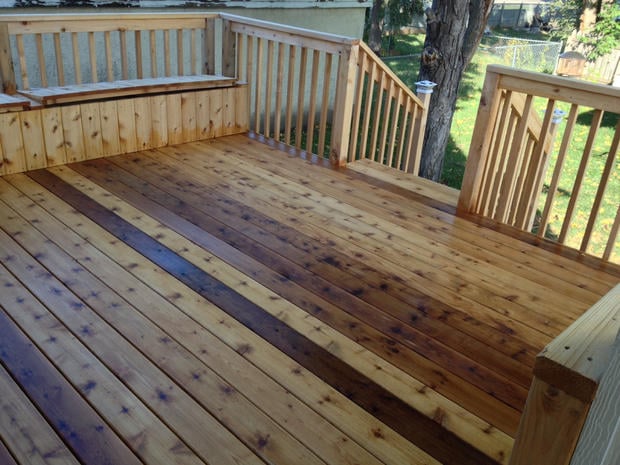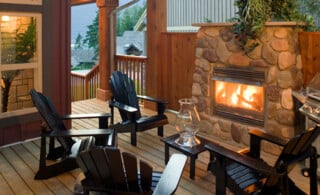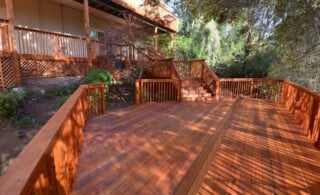
Decks have become an extremely popular, low-cost way to add living space to a home. Decks make it convenient to enjoy sitting outside day or night. They open up the home and facilitate entertaining and outdoor dining. Yet, decks are also subject to the damaging effects of weather. As such, deck maintenance is critical to prevent discoloration caused by dirt, moss, algae, and other plants. These deck enemies tear apart the surface of the wood. Splinters form, creating a rougher surface that is even more inviting to dirt and plants. Before long, you have a dingy deck that’s treacherous when wet and riddled with splinters.
Basic Deck Maintenance
1. Inspect and Prepare the Deck
As part of your deck maintenance, you should inspect your deck every year or two. Check especially for any loose boards or protruding nails that need repair. Clear the deck of any furniture or toys and cover all fragile plants. Next, sweep the deck of larger debris. Before beginning the cleaning process, make sure no children have access to the area.
2. Clean the Deck
Before you can apply sealant, you must thoroughly clean the deck of all dirt and build-up. Debris clogging the spaces between deck boards should first be blasted out with a powerful nozzle on a garden hose or a power washer. The water can also help dilute any chemicals that may inadvertently come into contact with plants and grass. (Even with mild solutions may contain plant-killing bleach.) Products with a base of non-chlorine bleach base or oxalic acid are used to eliminate discoloration and stains. Bleach-based products eliminate mildew, while acid-based materials handle graying and stains. But, be aware that bleach used to kill mildew can also leave a surface drab and washed-out. For these problems, an acid-based deck restoration product should be used.
Ready to start your deck care?
Find ProsBe sure to read the cleaning solution directions and warnings thoroughly. The solutions can usually be brushed onto the deck using a broom or it can be sprayed on with a power washer under low pressure. In general, the more powerful the chemical, the less scrubbing will be necessary. Scrubbing can be done by hand using a basic scrub brush or a push broom. After waiting the directed length of time for the chemicals to do their work, thoroughly rinse the deck. High-powered jets can be helpful, but too much pressure can gouge wood or cause the grain to become exaggerated.
Click this link if you need help from one of our contractors with your deck maintenance.
3. Paint or Stain the Deck
Though some people choose to paint their decks with deck paint, most take advantage of the natural beauty of expensive decking woods by using a clear or lightly stained finish for their deck. If you do choose to paint, use a stain-blocking oil or alkyd primer first. In general, the best finishes are those that soak into the wood, not those that provide a surface film. A heavily pigmented, solid stain isn’t really recommended for decking because it shows wear patterns and may peel. You want something that really soaks in. The cost to stain a deck will run you about $850.
There are three important characteristics to look for in a finish:
- The finish should be water repellent or waterproof, not just “water resistant.”
- The finish should offer ultraviolet (UV) protection.
- If mildew is a potential problem, the finish should contain a mildewcide, which a wood preservative does.
4. Seal the Deck
Once the area is dry, you must seal the deck. Put down tarps to protect plants, air conditioners, and other items that need protection from the sealant. The level of protection needed depends in part on how you are going to apply the sealant. Sealant can be brushed on, rolled on with a paint roller, or sprayed on. Spraying is the fastest by far, but this is also the hardest to control. And, some sealants have color that will stain surfaces to which they are applied.
Sealants are also rough on plants. While most plants won’t be damaged by getting hit with wafting over-spray, direct hits can do real damage. Sealants come in either water- or oil-based formulas. Professional sealants, which are typically superior, are oil-based. Some contain stain to tint the color of the deck. Sealants with stain don’t always deliver a uniform color across the wood, so try it first in an out-of-the-way spot to make sure the results match your expectations. A good quality sealant will also contain ultraviolet sunlight protection to reduce the damaging effects of the sun.
 Understanding Deck Construction
Understanding Deck Construction  Cleaning Your Exteriors With a Pressure Washer
Cleaning Your Exteriors With a Pressure Washer  Should You Build a Deck or Hire a Pro?
Should You Build a Deck or Hire a Pro?  3 Benefits of Under-Deck Stain
3 Benefits of Under-Deck Stain  How to Find & Hire the Right Deck Carpenter or Contractor
How to Find & Hire the Right Deck Carpenter or Contractor 

You should never seal a deck before staining as the article recommends. Sealing protects the wood from water/liquid penetration and will not allow any stain from penetrating into the wood. The instructions should be reversed, although oil based stains will not normally require a separate sealant as the oil base prevents water absorbance and water will bead up on the surface